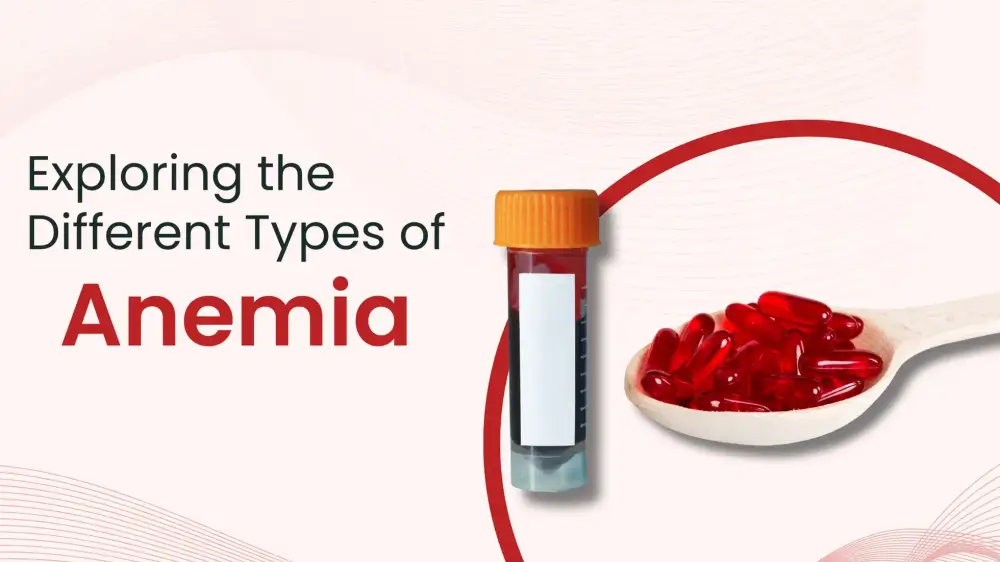
The term "anemia" circles diverse arrays of subtypes, each with its distinct characteristics and underlying causes. As we embark on this journey to explore the different types of anemia, we'll unravel the complexity of this condition and shed light on its varied manifestations.
Understanding anemia: A Brief Overview
Before we dive into the specifics of various anemia types, let's start with a fundamental understanding of what anemia entails. Our blood consists of red blood cells (RBCs), which carry oxygen to the body's tissues, and haemoglobin, a protein within RBCs that binds to oxygen. anemia occurs when there is a deficit of either red blood cells (RBCs), haemoglobin or both. The outcome of it results in reduced oxygen-carrying capacity, resulting in fatigue, weakness, and a range of potential health issues.
The Many Faces of anemia
. 1. Iron-deficiency anemia
anemia caused by a lack of iron, a fundamental element of haemoglobin, is arguably the most frequent type of anemia. This condition can be caused by different factors, such as inadequate nutrition, inadequate absorption of iron, prolonged periods of blood loss, or medical conditions that restrict the use of iron.
. 2. Aplastic anemia
Aplastic anemia is an uncommon but serious condition in which the bone marrow does not produce enough red blood cells (RBCs), white blood cells (WBCs), and platelets (PPAs). This may be due to exposure to toxic substances, radiation exposure, certain drugs, or even an underlying medical condition. Patients with anoplastic anemia typically have a weakened immune system, recurrent infections, and a heightened risk of haemorrhage.
. 3. Hemolytic anemia
Hemolytic anemia is a type of anemia in which the body prematurely destroys red blood cells at a rate that is too rapid for the body to produce new red blood cells. This condition can be inherited or acquired and is classified into several subtypes, including Autoimmune Hemolytic anemia and Sickle Cell anemia.
. 4. Megaloblastic anemia
Megaloblastic anemia is characterised by the presence of unusually large, immature RBCs. A deficiency in vitamin B12 or folic acid is typically the culprit behind this condition. It affects the normal maturation of red blood cells in the bone marrow and can lead to fatigue, weakness, and neurological symptoms.
. 5. Hemorrhagic anemia
Hemorrhagic anemia is a form of anemia caused by acute or chronic haemorrhage, resulting in a decrease in red blood cell count. It can be caused by gastrointestinal bleeding, trauma or surgery, and the severity of symptoms is largely determined by the rate and extent of blood loss.
Diagnosis and treatment
It is essential to determine the type of anemia to provide effective treatment. Diagnosis is typically made through blood tests, medical examinations, and a patient's medical history. Once a diagnosis is made, treatment plans can range from dietary modifications and iron supplementation for anemia caused by iron deficiency to more advanced therapies such as blood transfusions, medication, or bone marrow transplantation in more severe cases.
The Road to Better Health
The first step to managing and preventing anemia is understanding the different types. Regular health checks, eating a healthy diet rich in nutrients and timely medical treatment can significantly improve our chances of developing anemia.
Remember that anemia is treatable, and we can lead a healthier life with proper knowledge and care.
In this comprehensive guide, we have covered almost everything we need to know about anemia.
Each subtype of anemia has its own unique characteristics and medical research continues to advance our knowledge of this complex condition.
Whether you have been diagnosed with anemia or are looking to improve your healthcare knowledge, this guide is for you. Knowledge is pow